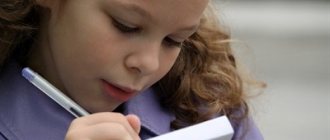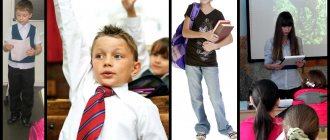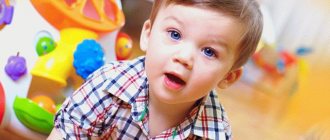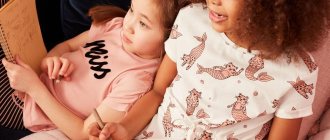Properties of motor skills and what causes them
Motor skills, i.e. the general physical preparation of a person and his development, are determined primarily by the correct construction and activity of the motor system. It is inextricably linked with the functioning of the nervous system. And, undoubtedly, the main role in performing various operations related to movement is played by the structure and condition of the osteo-articular and muscular system, spine, torso and limbs.
The components of motor skills are strength and endurance, coordination, body balance, as well as strength, mobility, reaction speed and ability.
There are 2 main types of motor skills - large and fine motor skills.
Fun exercises for older kids
Even simple exercises may have their contraindications depending on the developmental characteristics and health status of the baby. Therefore, before performing such exercises, it is necessary to consult with the pediatrician who is observing the baby. For example, diseases of the cardiovascular system may be a contraindication to active games and running. Allergic diseases require caution when using solutions for soap bubbles and playing with pillows (due to house dust); diseases of the musculoskeletal system limit riding a scooter or bicycle.
Catching up with soap bubbles
This game is suitable for kids who already walk and run confidently. On a walk or at home, blow soap bubbles and invite your baby to pop them with his palms.
It is impossible to predict the flight path of a soap bubble - that is why, trying to catch up with it, the baby will quickly change his movements, jump or, conversely, dodge.
Obstacle course
For this exercise we will need a balance bike, tricycle or scooter. Make obstacles out of plastic cones and invite your child to go around them. Another option for the exercise: draw a white line on the asphalt and ask your child to drive along it as smoothly as possible.
Aerialist
This is a home version of the chalk line exercise. Just place masking tape on the floor and let your little one walk across it with his arms outstretched. In addition, you can come up with a gaming legend. For example, that the ribbon is stretched high, high above the clouds, and the peaks of snow-white mountains are hidden under the legs.
Fine motor skills
Fine motor skills are the movements of the hand and fingers. It requires focus, attention and precision. For example, writing, drawing, carving, modeling clay, tying shoes, opening doors with keys, grabbing objects, sewing, fastening buttons, braiding hair, working on a computer using a mouse or touch screen.
(c)freepik.com
Game No. 13 “Even-Odd”
Goal: development of spatial orientation skills on paper; nurturing an emotional, positive attitude towards the game.
Material: 2 pens of different colors, checkered sheet.
Progress of the game: the border is marked on one edge and on the other. The distance is chosen arbitrarily by the players. Players must take turns marking a line (straight, diagonal squares) from end to next end of the square and so on. The one who reaches the border first (indirect borders) wins.
In addition to these didactic games and exercises, children can be offered various tasks involving the manipulation of objects: tracing, shading, lacing, fastening buttons, tying knots, various puzzles, mosaics, Legos, construction sets, embroidery, etc.
How is the child's motor skills developing?
A child's motor skills are consciously and unconsciously trained and improved from the first day after birth.
- As you know, by the sixth month of life, a baby should hold his head up and roll over from back to side. Be able to sit down holding an adult's finger.
- A baby up to one year of age must sit without support, crawl, put objects in containers, and hit them against each other.
- A child under 2 years old can walk, run, jump independently, arms wide apart, manipulate objects, roll a ball. And also climb up and down the stairs, holding onto the railings, and climb on your toes.
- A child under 3 years old should be able to climb stairs without the help of handrails and avoid obstacles. Definitely make attempts at self-care. However, he still needs support and help because his movements are not yet precise enough. During this period, basic “locomotive” actions are best mastered. The range of motor skills is expanding at a particularly rapid pace.
- Preschool child: Uses devices effectively, runs and jumps freely. His hand-eye coordination develops, his balance and vestibular apparatus improve, and his dexterity of movements is honed. By the end of the preschool period, the child fully masters all self-care skills. Able to combine several motor actions into a sequence. Grabs, throws, climbs a wall, a rope, over a fence. Copies the actions of others.
- Children of primary school age master almost half of the movements characteristic of an adult. They have skills in self-care, hygiene, care of clothes and room, and handling simple tools. Movements become harmonious, rhythmic and smooth. The age of 9-12 years is the “golden period of mobility.”
- During puberty, motor development tends to become unbalanced. There is a deterioration in the coordination of movements and the accuracy of their execution. In general, this is due to the fact that different organs and parts of the body develop in leaps and bounds. For example, for a couple of months only the legs grow rapidly, then the arms and neck. The growth of different organs and parts of the body is not interconnected. No wonder they say: “awkward, like a teenager.”
- By the age of 18-20, as a rule, the growth of the motor system is completed, the imbalances are leveled out and the quality of motor skills reaches the best levels.
Fun exercises for babies
This is my toy!
An activity option for a child who already knows how to grab and hold objects. When the baby is lying in the crib, put a soft rattle in his hands and gently, weakly pull it towards you. Let the baby try to pull the toy towards him. This exercise allows you to train your biceps, which are responsible for bending your arms at the elbow and turning your hands.
Expedition for children's treasures
Place your baby's favorite toys around the room or playpen and give him freedom of movement: let him try to crawl to his favorite bunnies, blocks and pyramids. This will awaken the child's interest in independent movements.
Multi-colored leaves
The exercise is suitable for babies who are already making their first attempts to stand on their feet, holding onto the sides of the crib. Glue several colored stickers on the wall next to the crib - they should be inaccessible from a sitting position. But it should be easy for the baby to get them by standing on his feet. Your little one will surely enjoy tearing leaves off the wall. Do not leave your child with stickers unattended.
Fine and gross motor skills - how to improve?
The development of gross and fine motor skills is paramount not only for full physical fitness, but also for everyday life. In order for a child to correctly perform complex movements of fine motor skills, it is necessary to have a firmly laid foundation of gross motor skills. Therefore, the priority task is coordination of movements, that is, the development of general mobility. And then, on this basis, you can develop the child’s motor skills.
Coordination requires movement of large parts of the body - arms, legs, torso, back, neck. Fine motor skills require the improvement of small parts of the body, in particular the precise movements of the fingers and hands.
There is no need to reinvent the wheel here - the methods have been known for a long time. For gross motor skills, these are outdoor activities, daily exercise, swimming, running, jumping. It will be very useful to attend sports sections, and even just physical education lessons at school.
For fine motor skills - interest groups, housework, cleaning the apartment, harvesting in the garden, interactive games and educational programs. For example, on our training service iqclub. Among the games you will find “Clicker” and other exciting programs for children.
Article:
Game “Scissors”
Purpose of the game: coordination of movements, training of hand muscles, concentration, development of fine motor skills of the hands.
Materials needed: a tray with scissors (preferably plastic ones with blunt ends) and several sheets of thick colored paper. Some sheets have cut lines marked.
Progress of the game: The presenter asks a riddle: Two ends, two rings, and a carnation in the middle. After the child has guessed correctly, the presenter offers to cut the paper with scissors. If the child did it easily, he is given the task of cutting along the lines and performing complex movements to cut out the pattern.
It should be taken into account that, having acquired the skills to confidently hold scissors, the child will then be able to hold a pencil and draw precise lines on paper with the same confidence.
Game "Little Pharmacist"
Purpose of the game: development of fine motor skills; finger movements, coordination.
Materials needed: On a small tray are tweezers, a cup with beads and a platform with slots for beads. There are exactly as many beads in the cup as there are cells in the platform. Each cell should be colored to match the color of the beads. You can use more beads at the beginning.
Progress of the game: The presenter talks about pharmacists and how they prepare various medicines. Shows how to transfer beads using tweezers. Then he invites the child to fill the cells with beads. When the platform is full, the beads are transferred back using tweezers. The game can be complicated by changing the size of the beads and platform cells. However, it should be taken into account that the game is quite complex and requires the child to have extreme concentration and internal control when working. If a child's bead falls onto the tray, he can always correct the mistake. Since the game requires great precision in movements, it is necessary to note each successful action of the baby.
Game "Colored Drops"
Purpose of the game: development of fine motor skills, finger movements, concentration, coordination.
Materials needed: On a tray is a platform for freezing water in the refrigerator. At the top, the platform is divided into three overlaps of red, blue and yellow. Next to the tray are 3 bottles of colorful water. The water is colored with yellow, red and blue food colors (you can use sparkling water). Each bottle contains a pipette with a thick rubber cap. Little sponge.
Progress of the game: The presenter shows how to transfer water from different bubbles using a pipette to the corresponding cells of the platform. The child repeats, and gradually the cells are filled with water in accordance with their color. The water is then transferred back into the vials using pipettes.
The child not only develops his fingers by working with a pipette, but also trains in the differentiation and distribution of colors, in their comparison and discrimination.
Game "Find the surprise"
Purpose of the game: development of fine motor skills of the hands, coordination of movements; teaching patience.
Necessary materials: candy wrappers (10-15 pieces), small items (badges, buttons, pebbles, etc.).
Progress of the game: The presenter wraps the badge in 4-5 candy wrappers. The child must unwrap all the candy wrappers and fold them carefully.
Game "Embroiderers"
Purpose of the game: development of fine motor skills, refined finger movements, concentration, coordination.
Materials needed: On a tray are sheets of cardboard with lines drawn on them. There are simple drawings, and there are more complex ones. There are holes on the lines where the needle and thread will go (in more complex tasks, these holes are only marked with a dot). A ball of woolen thread, 1-2 thick needles.
Progress of the game: The presenter talks about embroiderers, if possible, shows various embroideries and invites the child to play, explaining how they embroider. Then the child takes the needle and inserts the thread into the eye of the needle. At first, an adult helps him with this. Later he does it on his own. The ends of the thread are connected and tied into a knot. Then the child makes stitches on cardboard with holes (for a lighter option, you can use a cord instead of a needle), threading the needle up and down. It should be noted that working with a needle, especially threading and tying a knot, is very difficult for a small child. At first, it’s better not just to show, but to patiently perform these operations together with him, hand in hand, and accurately capture the moment when you can let go of the child’s hand and invite him to act independently.
Game "Lace up your shoe"
Purpose of the game: mastering the skill of dressing, developing fine motor skills, coordination, spatial orientation.
Materials needed: a pair of sneakers and laces.
Progress of the game: The presenter shows how to lace a sneaker and asks the child to lace the second sneaker in the same way. During the game, you must first show the lacing option and lace up with your child. As the game becomes more complex, you can only show ready-made samples.
Game "Beads"
Purpose of the game: development of fine motor skills, coordination, discrimination by shape and color of objects, concentration.
Necessary materials: thread, buttons of different sizes and colors.
Progress of the game: The presenter invites the child to make beads. You can give the task to make beads according to the sample, choosing buttons according to shape and color.
Game "Colorful clothespins"
Purpose of the game: development of fine motor skills of the hands, training in color discrimination, development of attention.
Materials needed: 2 sets of baskets with clothespins. The clothespins are painted red, yellow, blue, green (3 of each color). The basket can be replaced with a cup or plate, or a plastic bucket. The main thing is that the clothespins easily cling to the edges.
Progress of the game: The leader and the child each have a basket with colored clothespins. The leader takes the basket, puts it on the table and asks the child to give him a clothespin and name its color. If the baby doesn’t know, then the leader names the color himself. Then the presenter shows how you can attach a clothespin to the edge of the basket with three fingers.
When the child masters this action and can easily attach clothespins, for example, all the clothespins are the same color and name their color, he is given the task of attaching the clothespins in a certain color sequence, performing a certain sequence of clothespins as on the leader’s basket. You should pay attention to the fact that the presenter attaches the clothespins with three fingers, because the child must see the correct movements.
Repeated repetition of the movement of unclenching and squeezing clothespins trains the fingertips, provides a tonic massage and pressure on the muscle points responsible for activating the speech centers of the brain.
By observing which hand the child prefers to work with, you can determine the dominant hand. However, it is advisable for the child to work with both hands.
Game "Let's put it in order"
Purpose of the game: development of fine motor skills, coordination, discrimination by shape and color of objects, concentration.
How to play: Pour beads of two colors into a bowl (about 5-7 beads of each color) and place two saucers to the right of the bowl. Suggest: “let’s put all the red beads in one saucer, and all the green ones in the other.” To spice up the game, say, for example, that this is a treat for the bear and the bunny, and the bear only likes cherries, and the bunny only likes gooseberries. You need to move the beads one at a time, taking them with three fingers (show). If some beads fall on the table, ask them to pick them up with a scoop. Be sure to finish the job - this skill is very important. Therefore, at first, take fewer beads.
Game “Sprinkle with a Spoon”
Place two cups on the tray: on the left is a cup with cereal, and on the right is empty. (Both cups should be dry.) First, moving the child's hand, show how to take a partial spoonful of cereal, wait until the cereal stops falling from the spoon, and, smoothly moving your hand, move the spoon to the right cup and tip it over it. Help your baby pick up cereal when there is little left (tell him to bend the cup with his left hand). It is useful to combine this exercise with stirring. For example, a child can pour sugar into tea and place it himself.
Game “Come on, catch it!”
Place two plates on the tray: on the left - deep, and on the right - shallow. Pour water into a deep plate and throw in a few small floating objects. Invite your child to catch them one by one with a spoon and place them in a small plate. At first, help him by guiding his hand slightly. Make sure your child holds the spoon correctly. It is important to complete the exercise, transfer all items to a shallow plate, and collect spilled water with a sponge.
Game “Catch it out of the water”
Pour water into a bowl and throw in a few small floating objects: pieces of cork, twigs, etc. Invite your child to use a small sieve with a handle to catch all these items and place them on a plate on the tray to the right of the bowl. The baby should hold the sieve in his right hand.
Game "Magic Sieve"
Say: “Rice and semolina are mixed in this cup (show grains of rice and semolina separately). How to select all the rice grains from here? This is difficult to do even with your small and dexterous fingers. But a sieve will help you!” Separating one grain from another is like a magic trick for a child. Explain why this happens by first pouring clean semolina into the sieve, and then rice. The sifted rice should be poured into the prepared plate.
Game “Putting the cakes with a spatula”
For this exercise, you can “bake” cakes from plasticine or use small objects (for example, large buttons), or, outside, make them from snow or wet sand. The “cakes” should not be in the shape of balls so that they do not roll off the spatula.
Game “There was a puddle and it’s not there”
This exercise has great educational value: if a child spills something, he will be able to clean up after himself. First, teach your baby to transfer water from one plate to another with a sponge. Place two plates on the tray: on the left with a small amount of water, on the right empty. Demonstrate how to use a sponge by scooping water into one bowl and squeezing it over another. Please note that water should not drip from the sponge onto the tray. Then pour some water on the tray and show them how to wipe up the puddle by scooping it up with a sponge.
Game "Whipping cream"
Pour some water into a bowl and add a few drops of shampoo. Show your baby how to beat by holding the whisk correctly and making clockwise movements. The left hand should hold the bowl at this time. Draw your child's attention to the result - the appearance of foam. When the child begins to beat on his own, help him at first by slightly guiding his hand. Having finished whipping, the child must clean up after himself, carefully wiping away any puddles.
Game "Don't spill and don't spill"
First, pour some cereal into the jug and show your child how, holding the jug with his right hand and holding it with his left, pour the cereal into a glass standing to the left of the jug. (The child should sweep all spilled grains into a dustpan with a brush). Don't forget to discreetly praise your child if he cleaned up neatly. You should move on to transfusion only when the child has mastered oversleeping well. Help him start and finish the transfusion - this is the hardest thing for him. Show how to clean up spilled water with a sponge.
Game “Collecting mushrooms in the forest”
Place pieces of foam rubber on the floor and tell your child: “Here’s a basket for you, try to collect all the mushrooms in the clearing!” Show how to take pieces of foam rubber: with three fingers of your right hand. The collected “mushrooms” must be placed one at a time in the basket. Make sure your child collects all the “mushrooms”: this develops attention and teaches accuracy.
Game "Beads"
Purpose of the game: development of fine motor skills, coordination, discrimination by shape and color of objects, concentration.
Progress of the game: The presenter invites the child to make beads. You can give the task to make beads according to the sample, choosing buttons according to shape and color.
Game "Open and Close"
Come up with a game: for example, the baby can be a doctor who has a lot of jars of medicine, or a housewife who keeps different cereals in jars. Place several small jars with closed lids in front of the child (the jars should be different in size and shape). Offer to open all these jars, and then close them again, choosing the right lids. If the lids screw on, make sure your child twists the lid and not the jar.
Game “Collect all the beads”
Throw pebbles into the sand. (If playing at home, sprinkle on a tray). First, invite your child to collect pebbles with the first three fingers of his right hand (reinforcing the skill). Then show how to use the sieve: hold it in your left hand, and use your right hand to scoop sand into the sieve. The remaining stones in the sieve must be carefully poured into a bucket.
Game “Sprinkle the paths”
Invite your child to sprinkle “sand” (semolina, millet) on a 3-5 cm wide path on the table. Limit it with something, for example, strips of paper. Play: the path can go from one match house to another. Sand should be sprinkled with the same three fingers (folded in a “pinch”) without going beyond the edges of the path. When playing in the yard, you can make a path between two
Game "Find a Pair"
Pick up several pairs of identical small objects, for example two buttons, two cotton balls, two spools, etc. Place them in two identical paper bags: one item from the pair in one bag, the other item from the pair in another bag. Ask your child, without looking, to put his hand into the first bag and pull out any object from there. Now (again without looking) let him try to find by touch the exact same object in the second bag.











